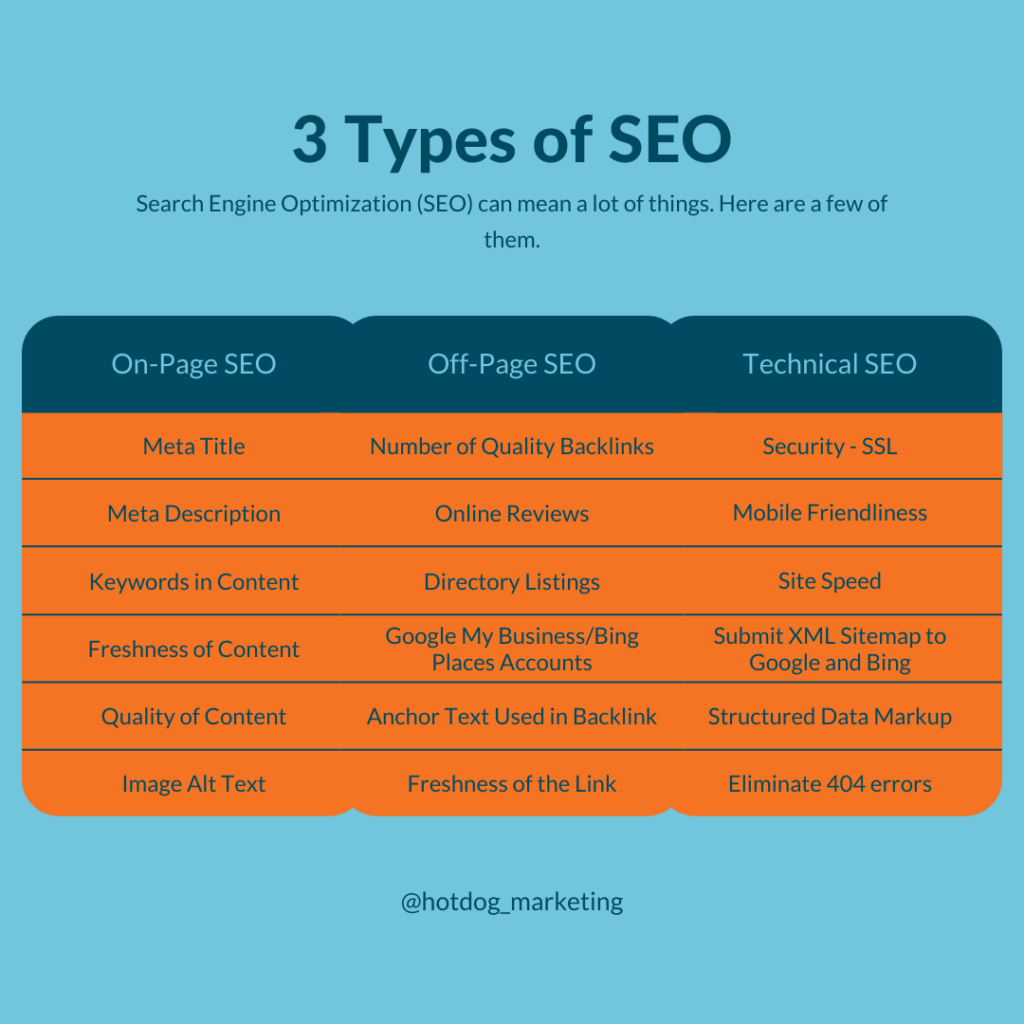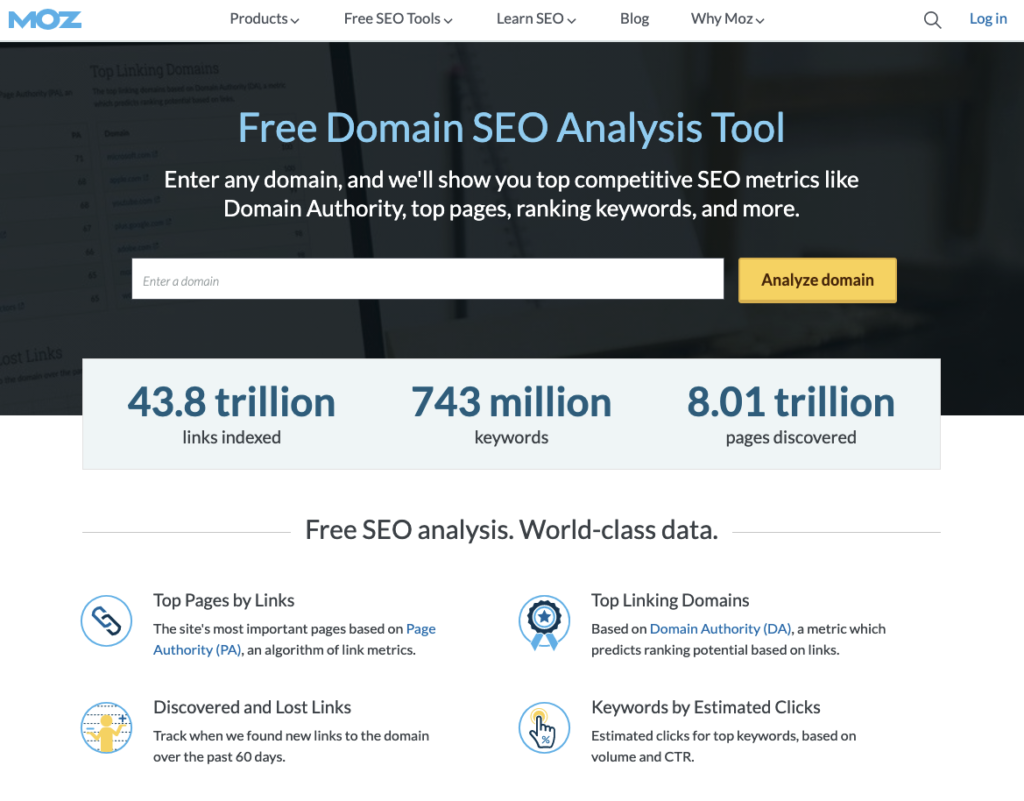What does SEO mean? SEO stands for “search engine optimization,” and it is the process of improving your website’s search engine ranking through online activities. These activities include increasing your website’s speed, creating and publishing excellent content and obtaining links from other credible websites to yours. SEO can be a topic often shrouded in mystery, but in this post, we’ve compiled all the information you need to know so that you can get started!
A Brief History of SEO

SEO didn’t start with marketers or website owners trying to increase their search ranking in Google, but SEO, as we know it today, is vastly dominated by it. Recent research shows that Google owns approximately 70% of the global desktop search market, and this means it is highly likely that your audience is using Google for search.
In contrast to many websites in the late 90s that were simply directories, Google’s search engine was built upon the idea that credible websites had many other websites linking to them, called “backlinks.” For example, an article from a credible news source, like the Wall Street Journal (WSJ.com) would likely have many links from other websites.
Conversely, a backlink from a very reputable website, such as WSJ.com, has a greater impact on your website’s search engine ranking than a backlink from a little-known blog. The diagram above shows how a network of websites linking to each other could be weighted for their importance in the eyes of the search engine algorithm.
As more people began using search engines to find information on the internet, the search results pages grew longer and longer. This meant that websites with the most credible information and backlinks were near the top of search results pages – this is how SEO was born.
Today, Google is much more evolved than in the late 90s. Google’s search engine has over 200 ranking factors (keep in mind that these are not public, so don’t go looking for them). Many have made conjecture or claim to know what those ranking factors are, but the truth is that the search engine algorithm has gotten so complex that no one person could really know everything that goes into the ranking.
Three Parts of SEO
SEO can be broken into three primary categories: on-page SEO, off-page SEO, and technical SEO. On-Page SEO includes having a title tag or meta description for every page on your website and the quality of content on that page. Off-page SEO includes backlinks from other websites and social media. Technical SEO includes things like site loading speed and structured data.

I know that list above looks a little intimidating.
“How can I conduct ALL these SEO tasks?”
Fear not! You don’t have to do all of them – just the important ones.
“How do I know which are the important SEO tasks for ranking,” you ask?
Unfortunately, we don’t know precisely how search engines weigh each ranking factor, and this means we’re in the dark when it comes to what to prioritize in our SEO efforts. However, thankfully many website owners and marketers have been at this game for a long time and provide insights that we can glean.
What to Prioritize for SEO
Marketers have been trying to rank in search engines for decades now, and in that time, they have experimented many, many times. What holds true is that quality backlinks and topical, relevant, high-quality content are two significant ranking factors, and the good news is that those are also quite actionable!
Backlinks for SEO
One consistent SEO factor across all search engine ranking algorithms is that backlinks to your website are crucial. What this means for us, then, is that we should focus on obtaining links from other high-quality websites with relevant content related to yours—yes, related to yours. A backlink from a well-respected pizza blog won’t do much to affect search ranking for your website for cybersecurity consulting.
Create a Link Building SEO Strategy
An SEO strategy around link building could be as simple as producing excellent, shareable content and publishing it to your website. It could also include an outbound aspect, such as reaching out to relevant web admins or online influencers and asking them to share your content with their audience (linking to your website in the process). There are many different ways to create a link-building SEO strategy – it all depends on what content you can produce, what your audience (and similar ones) will enjoy consuming, how to find related content publishers, and how much time you are willing to devote.
Here are some activities you could include in your link-building SEO strategy:
- Regularly publish high-quality blog content
- Create fun or informative videos that engage
- Create infographics
- Create online tools or calculators
- Embed “tweet this” widgets into your content
- Cold outreach via email to another publisher, asking them to share your content and link to your website
- Cold outreach via email to a relevant publisher, asking them to link to your website in exchange for you linking to theirs
- Identify broken links on popular articles or websites, then reach out to the webmaster and suggest a link to your relevant, active piece of content instead
- Identify linked content in popular articles or websites that is outdated or poor quality, then reach out to the webmaster and suggest a link to your relevant, active piece of content instead
- Instead of creating content, then finding a publisher to backlink to you, find a popular article that could benefit from an expansion on a topic in which you are an expert, then create that content piece and suggest to the webmaster that their article link to yours
Backlink Strategy Examples
While many reputable online publications will receive backlinks due to the nature of their work, other companies have made shareable content a priority. They use this to drive their backlink campaigns and build more credibility.
For example:
1. @Bloombergopinion

This Instagram account based on the opinion arm of the software company Bloomberg does an excellent job of creating social media posts that are quick to understand and compelling. This makes users naturally want to share them, linking back to their Instagram account with the hopes of gaining more followers.
2. BuzzFeed

Everything about BuzzFeed is built to share. There are clickbait-y headlines for all their articles (or “listicles”) and they have numerous quizzes about literally everything (see Order a Massive Breakfast and We’ll Reveal Which Disney Character You Truly Embody). You can’t not send these links to your friends (or co-workers).
3. Moz.com

Moz.com is one of the most popular companies offering SEO tools. They have a subset of tools available for free on their website. For those just getting started in SEO, this “freemium” model gives them the opportunity to use an SEO tool without paying enterprise rates. Since the tool is free, online publishers are quick to link to it.
High-Quality, Relevant Content for SEO
The other ranking factor I’ll focus on is content. But not just any content; content for content’s sake is not helpful. In the SEO world, we often call this “thin” content. To receive the maximum benefit from your content-writing SEO efforts, the content you publish should be related to the topic of your website.
Sure, you might have strong opinions about the best kinds of pizza toppings that you feel a burning desire to share with the world, but what does that have to do with cybersecurity? Nothing – so it probably shouldn’t go on your website.
Search engines will interpret this swath of irrelevant content as a dilution of your intent: to get a targeted audience that is interested in what you have to sell to your website. On the other side of the coin, when search engines see a deluge of high-quality content on your website related to your topic, they’ll view you (or your business) as an expert on the topic.
Create a Content Strategy for SEO
Producing high-quality content often doesn’t simply come from writing whatever you feel like in the moment, whenever that moment presents itself. It requires a strategy to ensure that the content you create is actually high-quality and relevant.
This situation reminds me of TV sitcoms from back in the day (you know, with like – cable). More often than not, it was obvious to the viewers that writers for TV sitcoms didn’t know what they were going to write about for every single one of the 24 episodes in a regular season of their show. Some episodes were great, some flopped – but they were almost all simply self-contained. There was no grand overarching story in most cases.
Compare that to how streaming networks produce TV shows and (the ever-increasingly popular) mini-series. A TV show produced by a streaming service is more likely to have a grand theme and solid through-line, developing the big story in every episode. In this way, each episode feels more like a chapter in a book.
The difference is that cable TV shows simply need to fill airtime – so they write about whatever they can. TV shows produced by streaming services are intentional and tell the story in a way that makes progress in every episode. (I know, I’m really showing my hand here as a Millennial.)
Anyway, what do you include in a wonderful content strategy that helps SEO? Here are some examples:
- Blog posts sharing your expertise or unique insights into your industry
- Blog posts covering industry trends
- Blog posts covering a recent newsworthy event
- Blog posts that highlight your company’s core values or mission
- Case studies highlighting positive results and challenging problems your business overcame for clients
- Analysis of your own proprietary (or someone else’s) data
- Infographics on little-known aspects of the industry or industry trends
- Explainer videos
- Videos about your clients
- Instructional videos showing how to use your product or service
- Videos about how your product has made a difference for your clients (somewhere in between testimonial, case study, and entertainment)
- Interview videos with you, your staff, clients, or industry experts
- Podcasts
- Social media posts
- Whitepapers
- E-books
- And many more…
Content Strategy Examples
1. HubSpot

I’ve mentioned HubSpot’s content strategy in previous posts before – but that’s because it’s simply astounding. They went all-in on content marketing and now have a vast content library covering all things related to digital marketing and marketing automation.
2. Mailchimp
I was not expecting a video series from an email marketing automation software! Yet, here it is. Mailchimp created a videos series for and about their target customers – small business owners and entrepreneurs. They tell quick, compelling stories in a way that doesn’t come off as a promotional ad.
3. Hot Dog Marketing

Yes, we’re tooting our own horn here a little bit. Hot Dog Marketing’s website has a substantially large and inclusive blog on anything from…well, writing blogs to creating strong and eye-catching social media posts and everything in between. Our content creators have years of experience in crafting content plans that fit with our clients’ business models and goals. No cookie cutter strategies, just thoughtful and thorough pathways to success.
Implement SEO with Hot Dog Marketing
Even a little effort towards SEO can help your website rank better for target queries, but with so many opportunities for improvement, hiring a marketing agency like Hot Dog Marketing is a smart move. We already know how to optimize websites for search engines, so you don’t have to spend your time learning. Instead, you can focus on your own business and providing the most value where you can. Leave the SEO to us. It doesn’t matter if you have a brand-new website or one that’s been around since the 90s – we offer universally beneficial SEO services. Even better, we know that your website doesn’t exist simply to make the search engines happy–everything we do make your website experience pleasant for robots and humans.

Tom Snyder is a business-minded writer creating compelling content that helps business owners understand the digital side of their business and engage with their audience. Constantly intrigued by learning new things, he is fascinated with tech, business, and sci-fi. In his spare time, you can find Tom building his own business (coffee roasting) or making music.